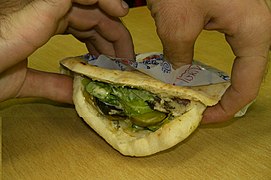|
Sabich
Sabich or sabih (Hebrew: סביח [saˈbiχ]; Judeo-Iraqi Arabic: صبيح) is a sandwich of pita or laffa bread stuffed with fried eggplants, hard-boiled eggs, chopped salad, parsley, amba and tahini sauce. It is a staple of Israeli cuisine and was created by Iraqi Jews in Israel in the 1960s. Its ingredients are based on a traditional quick breakfast of Iraqi Jews; while in Iraq, the ingredients were served separately, the modern sabich, where all of them are eaten together in a sandwich, was created in Israel, where it is sold in many businesses. Etymology There are several theories on the origin of the name Sabich. Many attribute the name to the sandwich's creator, Sabich Tzvi Halabi, who was born in Baghdad in 1938 and immigrated in the early 1950s.[1][2][3] The name Sabich means "morning", which may be a reference to the fact the ingredients are those of a typical shabbat breakfast among Iraqi Jews.[4] Popular folk legend attributes the name to an acronym of the Hebrew words "Salat, Beitsa, Ḥatsilim" סלט ביצה יותר חציל, meaning "salad, egg, eggplant".[3][5] This is probably a humorous interpretation and hence a backronym.[5] History  Halabi bought a kiosk across the street from the last stop of the Number 63 bus on Uziel Street in Ramat Gan in the early 1960s. Local workers wanted something more substantial than the bourekas the kiosk was currently selling, and Halabi and his wife created a sandwich based on an Iraqi traditional shabbat breakfast of eggs, tebit, chamin, fried eggplant, and salad.[6][7] Eggplant is a year-round crop in Israel, and eggs were available during the period of austerity in Israel, so both ingredients had long been in common use in the early 1960s.[5] In Israel, the sandwich became a popular street food. Halabi took on a partner, Yaakov Sasson, and in the early 1980s moved the operation to Negba street, where as of 2017 it was still in operation.[3][6] The dish is served throughout Israel.[6][3] It is not well-known outside of Israel.[5] In 2020 the mayor of Ramat Gan announced the Nagba Uziel intersection would be named Sabich Square.[8] Ingredients and descriptionSabich typically includes fried eggplant slices, a cucumber-and-tomato salad, amba, and haminados eggs, which are slow-cooked in hamin until they turn brown.[6] Some versions include potatoes, pickles, a tahini sauce, hummus, or other condiments.[1][3][5][9] It is commonly served in pita bread or wrapped in laffa, an Iraqi flatbread.[1] Daniel Gritzer, writing for Serious Eats, describes the sandwich as "it's drippy, it's messy, it's shamelessly moist and flavorful. There are creamy swaths, and squishy bits, and crunchy chunks, and tart bursts".[9] A version without the bread or pita is called Sabich salad ("סלט סביח" - "Salat Sabich" in Hebrew). Importance in Israeli cuisineAccording to Ronit Vered, writing in Haaretz, the sandwich became "an integral part of the limited canon of Israeli cuisine". Tami Shem-Tov wrote Saba Sabich (Grandpa Sabich), a children's picture book published in 2017 by Kinneret Zmora-Bitan in Hebrew, which according to Yahil Zaban of Tel Aviv University details how the sandwich became "a symbol of the new Israeli culture".[6][10] According to Janna Gur, the sandwich is "the first street snack that sprang from a Jewish culinary tradition" in Israeli cuisine and was more popular in Israel than falafel.[7] GallerySee alsoReferences
|
||||||||||||




